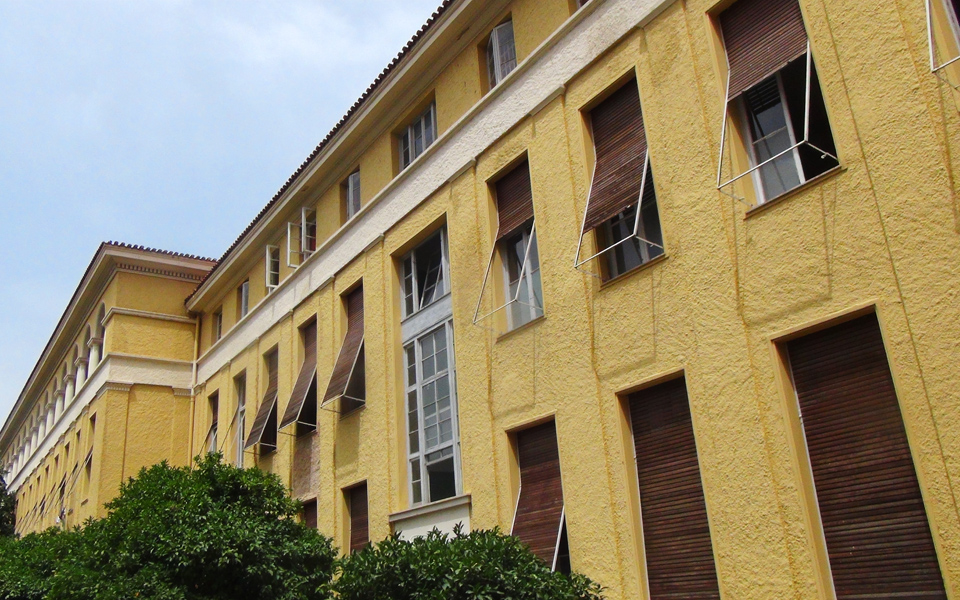On Pontou street in the central Athens district of Ambelokipi stands a two-storey house built in 1927. It was designed and inhabited by an engineer, Theofilos Papadopoulos, born in 1900 in the Black Sea region of Pontus.
After completing his studies at the Athens Polytechnic, he worked at the Ministry of Public Works, where he was commissioned to plan the roads in the area. Because of the region’s history as a settlement for Pontic Greek refugees following their expulsion from their homeland after 1922, the area was named New Pontus and the streets were named after places in the region, such as Pontou, Kerasountos and Trapezountos streets.
In Agios Panteleimon, another central Athens district, a burglary on the ground floor of the house built by a businessman named Halkas in 1907 led him between 1918 and 1922 to add one more floor to the building, where he lived with his family feeling more secure.
Years later during the German occupation in the Second World War, Fani Drosogianni, then a child, remembers a young man who was on the run from the Germans hiding in the basement of her home on Solonos street.

Buildings represent the stories of the people who lived in them. They are what give a soul to the shell. And with these oral testimonies collected by the team from Monumenta, a nonprofit organization that works for the protection of the natural and architectural heritage of Greece and Cyprus, many Athenian buildings have become a voice to revive past decades, mainly the 1950s and 60s but as far back as the Second World War.
The aim of Monumenta’s extensive project, which began three years ago and is in its final stages, is to record buildings in Athens dating from 1830 to 1940. The idea was born when Monumenta began receiving complaints about old buildings being demolished or scheduled for demolition. Since their histories were not documented, there was no possibility of saving the structures. The Stavros Niarchos Foundation stepped in to finance this entire project, which not only led to the creation of a priceless database of buildings but also the gathering of oral testimonies and stories from the owners who lived in and, in cases, continue to live in them.
After the creation of a common protocol to be followed in cataloging the buildings, a core group, consisting of Irini Gratsia, Fotini Bellou, Giorgos Ninos, Zanni Pittakidi and Georgia Goumopoulou, took on the task of combing through Athens for buildings. So far, the group has recorded more than 10,000 buildings in the seven central districts of the city, with the valuable contribution of some 300 volunteers: graduate engineers and architects mainly, but also archaeologists and even some doctors and artists who showed interest.

The greatest built wealth is concentrated in the districts of Exarchia, Neapoli and Kolonaki, where 4,000 of the buildings are located. The districts with the fewest structures of interest were Ambelokipi, Gyzi and Erithros Stavros, with 730 buildings. Most of the buildings in these neighborhoods were demolished in the 1930s, but some remarkable public buildings have survived, such as the Elpis, Elena and Agios Savvas hospitals.
NEOCLASSICAL CRAZE
On one of her most recent trips in Exarcheia, we followed archaeologist Irini Gratsia, one of Monumenta’s founding members. We walked along small roads and came to a halt in front of some early 20th-century buildings on Methoni street. Dating from the 1920s, these homes are examples of the so-called “neoclassical craze.” Built for the poorer sections of society, they still followed a specific form and structure.
“This road is a prime example of many similar ones that exist and give identity to Athens, which is not formed by the palaces and mansions of Vasilissis Sofias avenue and other streets like it. Athens is mainly a middle-class city with many buildings to be rescued. And if you want to protect something, you have to document it very well,” said Gratsia.
“Buildings represent the stories of the people who lived in them. ”

SMARTHONE APPLICATIONS
Disputes between tenants, over-taxation, lack of maintenance and lack of interest by the relevant bodies are the main reasons why many of these buildings have been abandoned. However, the valuable material gathered by Monumenta has created a protective shield for heritage buildings in Athens. They have been entered into a database called Docathens, which contains basic information about each building and will be updated constantly.
The next step is to launch a smartphone application, which has already been prepared, that gives the user free access to all of this information. With the application, the user can choose routes of interest to follow or give his or her current location and time to spare and receive suggestions for buildings to visit nearby.
More information: www.docathens.org/en/











